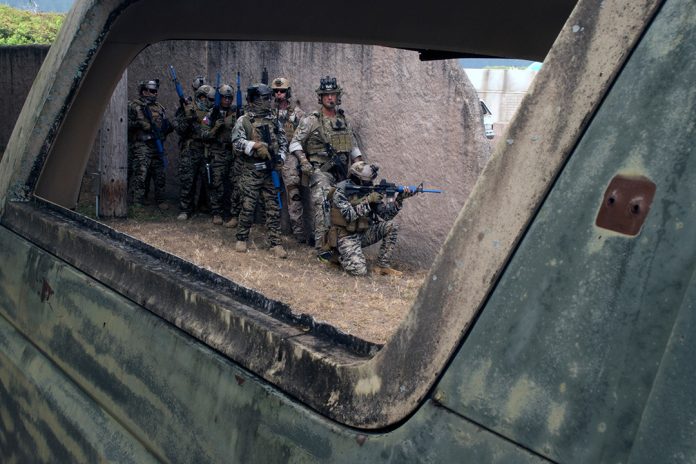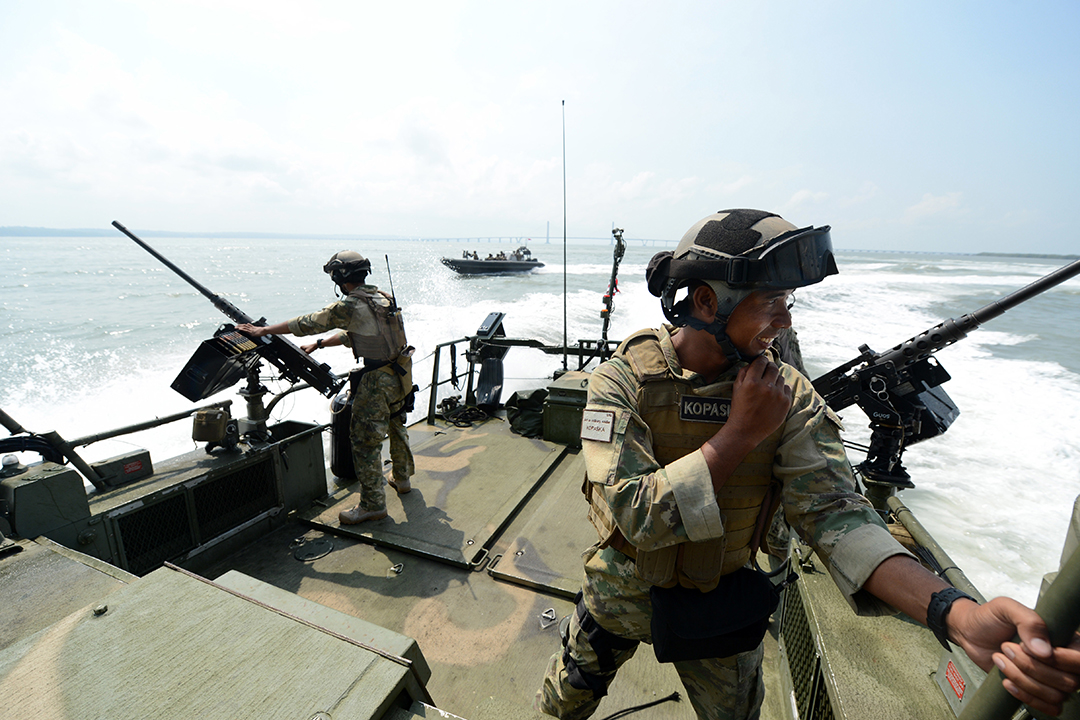
Published in the November/December 2020 Issue – Special operations training programmes across the Indo-Pacific region have been significantly hampered by the ongoing COVID-19 pandemic.
Special operations force (SOF) sources there have indicated to Asian Military Review how bi- and multi-lateral training efforts have been either postponed or cancelled as a direct result of COVID-19. Such restrictions come at a time when SOF units continue to demand improving levels in cooperation and interoperability in order to plan and conduct joint special operations. However, SOF units are refocusing on unilateral training opportunities in order to maintain currency to conduct the full spectrum of special operations.
One of the most high profile examples of this came during the biennial Rim of the Pacific (RIMPAC) exercise. Scheduled to be run across the island of Oahu, Hawaii, RIMPAC 2020 had planned to bring together the greatest number of Indo-Pacific SOF elements from across the wider region with participants including US Army Special Forces; South Korean Navy SEALs; Brazil’s GRUMEC; India’s MARCOS; Peru’s Naval Special Warfare; Chile’s COMFUES; The Philippines NAVSOG; and Japan’s Special Boarding Unit.
Due to take place across multiple training locations on Oahu and off the coast including Joint Base Pearl Harbor Hickam, Marine Corps Base Kaneohe Bay and Bellows Air Force Base, the exercise would have provided an additional opportunity for participating SOF elements to enhance levels of cooperation and interoperability.
Speaking to AMR, service officials from the US Special Operations Command Pacific (SOCPAC) explained how the exercise would have focused on enhancing the “command and control of SOF forces within RIMPAC; multinational interoperability training; direct action raids; and maritime/dive operations”.
SOCPAC also confirmed how RIMPAC 2020 had been scheduled to include ‘Ship in a Box’ training; special insertion by helicopter, military free fall insertion, small boats and submarines; in addition to visit, board, search and seizure (VBSS) operations at sea.
The cancellation of the exercise served a significant blow to Indo-Pacific SOF units seeking to benefit from training serials with US SOF in particular. The next SOF-specific RIMPAC exercise is scheduled to take place in 2022.
In May 2020, South Korean SOF leadership made the decision to postpone or cancel its remaining multi-lateral training programmes in 2020 due to the ongoing pandemic. As AMR went to press, the decision had yet to be revised.

China trains for SOF-on-SOF
The People’s Republic of China continues to press ahead with unilateral special operations training despite international travel restrictions associated with the pandemic.
In August 2020, People’s Liberation Army SOF participated in a maritime counter-terrorism (MCT) exercise at a location along China’s coast. Designed to enhance PLA SOF’s ability to conduct SOF-on-SOF engagements, the exercise saw PLA SOF units employing civilian heavy lift surface vessels as motherships to launch and recover helicopter assault forces.
Such a mothership concept, which is also being pursued by the likes of US and UK special forces, falls in line with the National Defence Transportation Law published by the People’s Republic of China in 2016, which earmarked the utility of commercial ships to support special operations.
Defence sources explained to AMR how this concept would significantly extend the ability of PLA SOF to reach some of the more remote disputed island chains in the South China Sea (SCS) including the Spratlys and Paracels.
Similar special operations exercises continue to be conducted by state actors across the Indo-Pacific which remain fearful of foreign intervention. The South Korean SOF, in August 2019, conducted the “East Sea Territorial Protection Exercise” around the Dokdo/Takeshima Islands, the ownership of which is disputed with Japan.
Elsewhere, PLA SOF also conducted a special operations training exercise in the area of the Tibet Military Command. The exercise, which was conducted in June 2020, followed a high-profile engagement conducted between Chinese and Indian border forces in Ladakh.
An official statement published by the Chinese Ministry of Defence confirmed how the unilateral training exercise conducted in the Nianqing Tanggul mountain range, had included the support of close air support, artillery and electronic warfare teams. Specifically, SOF operators conducted special reconnaissance tasks as well as insertion/extraction and target acquisition at high altitude.
Similarly, Indian SOF continue to build their own capabilities following the event in Ladakh. Examples include a Joint Combined Exercise Training (JCET) opportunity with US Army Special Forces which was conducted in the US despite the ongoing COVID-19 pandemic.
Conducted at Joint Base Lewis McChord in Washington State, the JCET provided Indian Army Para SF operators with the opportunity to practise urban warfare serials. Similarly, India’s paramilitary unit, the NSG, also hosted US SOF as part of a bilateral training opportunity in Hyderabad in the third quarter of 2020.
Similar focus of protecting strategic waterways across the Indo-Pacific to ensure maritime security was also demonstrated throughout 2020 by Indonesian SOF.
In July 2020, the Indonesian Navy’s SOF component, KOPASKA, participated in a training package in the Strait of Dom, West Papua, as part of a wider effort to ensure maritime security across the area of responsibility.
With a focus on small unit special operations, the exercise saw KOPASKA conducting sub-surface insertions into target areas using combat dive teams in addition to amphibious direct action missions by rigid hull inflatable boats and other surface vessels.
The exercise was preceded by a joint training opportunity between KOPASKA and the Indonesian Navy at Damar Island. Designed to enhance levels in cooperation and interoperability between both force components, the exercise saw the execution of beach assault operations; hostage rescue serials; and interdiction missions, with SOF units supported by helicopters and high speed interceptor craft.
Indonesian Army SOF from the KOPASSUS Special Warfare Command had also been scheduled to revive bi-lateral training opportunities with the US Special Operations Command over the course of 2020.
The decision followed a decision by the US State Department in 2019 to revive relationships with KOPASSUS following concerns of humanitarian rights violations.
In May 2019, former US defence secretary Patrick Shanahan visited Indonesia to meet with counterparts to discuss future training opportunities. However, such cooperation was put on hold due to the COVID-19 pandemic.
As AMR went to press, no decision had yet been made regarding the reinstatement of bilateral training opportunities.
SOCOMD
The Australian government has established a dedicated training organisation to support emerging requirements of the Australian Special Operations Command (SOCOMD).

The Defence Special Operations Training and Education Centre (DSOTEC) was established in November 2019, co-located at the headquarters of the 2nd Commando Regiment at Holsworty Barracks in New South Wales.
With a remit to “conduct individual special forces recruitment, selection, training, and education to meet force generation, trade, and professional development requirements” for SOCOMD, the DSOTEC is also described by official literature as “central to ensure that Australia special forces are fit for the future”.
The decision to stand up the DSOTEC comes at a time when the SOCOMD is bracing itself to respond to the forthcoming publication of a report into alleged warcrimes in Afghanistan in the early to mid 2000s.

“This evolution reflects the changing strategic environment and capability requirements to conduct Special Operations. Through this time we have seen the principles of Special Forces reaffirmed to include quality not quantity; joint ways of operating; command at the highest appropriate level for optimum effect; and an ethos of relentlessly pursuing excellence,” service officials announced at an opening ceremony of the DSOTEC.
“We also know that effective special operations are about people, and these can’t be grown quickly. These attributes grow from solid fundamentals and strong foundations built in the ‘raise, train and sustain’ system that enable the flexibility and agility essential to prosecute Special Operations,” it was added.
Finally in Singapore, the country’s Special Operations Task Force (SOTF) remains focused on uni- and bi-lateral training opportunities in order to “step up readiness” to respond to emerging threats across the Indo-Pacific, according to service officials.
The SOTF is set to benefit from the Singapore Armed Forces Training Institute (SAFTI) City complex- a 88ha site developed to enhance urban warfare training.
The training site, which began to be constructed in June 2019, will feature a total of 80 building structure some of which are as high as 12-storeys, allowing SOTF assault teams to practise special operations in dense urban environments.
The complex is also set to accommodate a bus terminal and railway stations, in addition to subterranean structures.
A first phase of the SAFTI City is expected to be completed by 2023 which will allow SOTF to transfer a lot of specialist training from the smaller Murai Urban Training Facility.
by Andrew White












